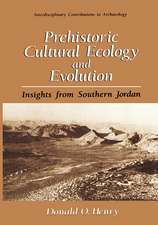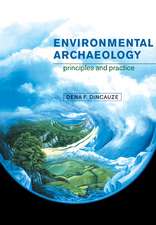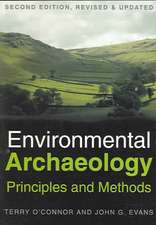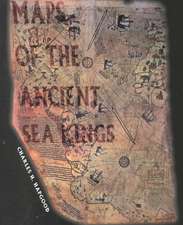Environmental Archaeology: Manuals in Archaeological Method, Theory and Technique
Autor Elizabeth Reitz, Myra Shackleyen Limba Engleză Paperback – 5 noi 2013
| Toate formatele și edițiile | Preț | Express |
|---|---|---|
| Paperback (1) | 591.29 lei 43-57 zile | |
| Springer Us – 5 noi 2013 | 591.29 lei 43-57 zile | |
| Hardback (1) | 652.46 lei 43-57 zile | |
| Springer Us – 24 mai 2012 | 652.46 lei 43-57 zile |
Preț: 591.29 lei
Preț vechi: 695.63 lei
-15% Nou
Puncte Express: 887
Preț estimativ în valută:
113.18€ • 122.98$ • 95.13£
113.18€ • 122.98$ • 95.13£
Carte tipărită la comandă
Livrare economică 21 aprilie-05 mai
Preluare comenzi: 021 569.72.76
Specificații
ISBN-13: 9781461496441
ISBN-10: 1461496446
Pagini: 560
Ilustrații: XLIV, 516 p. 151 illus., 7 illus. in color.
Dimensiuni: 155 x 235 x 29 mm
Greutate: 0.78 kg
Ediția:2012
Editura: Springer Us
Colecția Springer
Seria Manuals in Archaeological Method, Theory and Technique
Locul publicării:New York, NY, United States
ISBN-10: 1461496446
Pagini: 560
Ilustrații: XLIV, 516 p. 151 illus., 7 illus. in color.
Dimensiuni: 155 x 235 x 29 mm
Greutate: 0.78 kg
Ediția:2012
Editura: Springer Us
Colecția Springer
Seria Manuals in Archaeological Method, Theory and Technique
Locul publicării:New York, NY, United States
Public țintă
GraduateCuprins
Introduction to Environmental Archaeology.- Factors Affecting the Composition of an Assemblage.- Research Designs and Field Methods.- Classification and Nomenclature.- Sediments and Soils.- Seeds, Fruits, Nuts and Tubers.- Woods and Charcoal.- Pollen.- Phytoliths, Starch Grains and Spores.- Micro-organisms.- Arthropods: Spiders and Mites, fleas, Chironomids, Lice, Beetles, Rickettsiae, Ostracods, Nematode Worms, Crabs, Shrimp.- Echinoderms and Molluscs.- Vertebrate Bones and Teeth.- Other Vertebrate Tissues.- Stable Isotopes, Trace Elements, Ancient Genetics and Enzymes.- Conclusion.
Recenzii
From the reviews:
“This handbook by Reitz (anthropology, Univ. of Georgia) and Shackley (Culture Resource Management, Nottingham Business School, UK) is a revised and dramatically enlarged update of Shackley’s 1981 Environmental Archaeology … . Each chapter concludes with a section on applications followed by a complete, up-to-date bibliography. … this handbook will be of most value to serious students and professionals. Summing Up: Recommended. Upper-division undergraduates and above.” (W. Kotter, Choice, Vol. 50 (4), December, 2012)
“This handbook by Reitz (anthropology, Univ. of Georgia) and Shackley (Culture Resource Management, Nottingham Business School, UK) is a revised and dramatically enlarged update of Shackley’s 1981 Environmental Archaeology … . Each chapter concludes with a section on applications followed by a complete, up-to-date bibliography. … this handbook will be of most value to serious students and professionals. Summing Up: Recommended. Upper-division undergraduates and above.” (W. Kotter, Choice, Vol. 50 (4), December, 2012)
Notă biografică
Dr. Elizabeth Reitz is a Professor of Anthropology at the University of Georgia. She is also a member of the Executive Committee, International Council on Archaeozoology and the International Committee, International Council on Archaeozoology. She is currently the Director of the University of Georgia's Center for Archaeological Sciences.
Dr. Myra Shackley is affiliated with the Nottingham Business School at Nottingham Trent University. She is a former head of the Centre for Tourism and Visitor Management at Nottingham Business School.
Dr. Myra Shackley is affiliated with the Nottingham Business School at Nottingham Trent University. She is a former head of the Centre for Tourism and Visitor Management at Nottingham Business School.
Textul de pe ultima copertă
One of the most significant developments in archaeology in recent years is the emergence of its environmental branch: the study of humans’ interactions with their natural surroundings over long periods and of organic remains instead of the ceramic, lithic and architectural elements generally associated with sites. With the current attention paid to human responsibility for environmental change, this innovative field is recognized by scientists, conservation and heritage managers, and policymakers worldwide.
In this context comes Environmental Archaeology by Elizabeth Reitz and Myra Shackley, updating the seminal 1981 text Environmental Archaeology by Myra Shackley. Rigorously detailed yet concise and accessible, this volume surveys the complex and technical field of environmental archaeology for researchers interested in the causes, consequences, and potential future impact of environmental change from the perspective of archaeology. Its coverage acknowledges the multiple disciplines involved in the field, expanding the possibilities for using environmental data from archaeological sites in enriching related disciplines and improving communication among them. Introductory chapters explain the processes involved in the formation of sites, introduce research designs and field methods and walk the reader through biological classifications before focusing on the various levels of biotic and abiotic materials found at sites, including:
In this context comes Environmental Archaeology by Elizabeth Reitz and Myra Shackley, updating the seminal 1981 text Environmental Archaeology by Myra Shackley. Rigorously detailed yet concise and accessible, this volume surveys the complex and technical field of environmental archaeology for researchers interested in the causes, consequences, and potential future impact of environmental change from the perspective of archaeology. Its coverage acknowledges the multiple disciplines involved in the field, expanding the possibilities for using environmental data from archaeological sites in enriching related disciplines and improving communication among them. Introductory chapters explain the processes involved in the formation of sites, introduce research designs and field methods and walk the reader through biological classifications before focusing on the various levels of biotic and abiotic materials found at sites, including:
- Sediments and soils.
- Viruses, bacteria, archaea, protists and fungi.
- Bryophytes and vascular plants.
- Wood, charcoal, stems, leaves and roots.
- Spores, pollen and other microbotanical remains.
- Arthropods, molluscs, echinoderms and vertebrates.
- Stable isotopes, elements and biomolecules.
Caracteristici
First book to enable readers to learn about the wide range of materials and methods in environmental archaeology Helps to evaluate and discriminate among methods Continues in the tradition of the first edition, published by Plenum, while also bringing in advances and updates in the methodology of the field itself




























